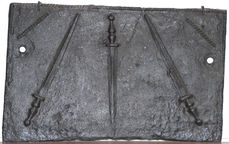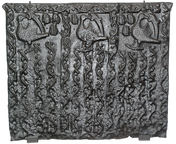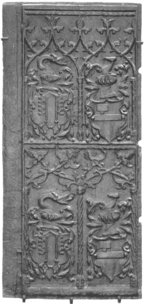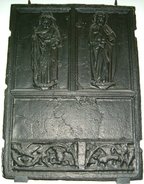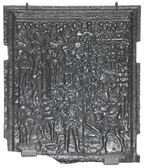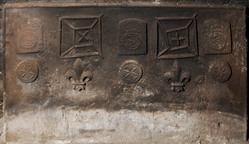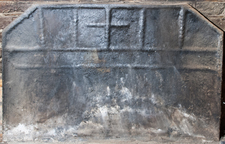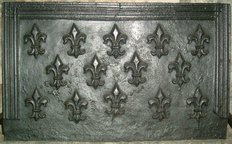-
727
Description: Rectangular; twisted rope edging (top and sides); canted rope lengths across top corners; three impressions of a rondel dagger (c. 410mm) with a baluster-turned grip, the middle one per fess, pommel in chief, the other two on either side, per bend, points in chief.
Notes: The arrangement of daggers is similar to the arms of Vigures, of Launceston, Cornwall, but inverted; the plate has been pierced on each side for fixing to the back of the fireplace; the dagger (length approx. 41cm) may be of German design.
- Decoration tags:
- rectangular (shape)
- rope (edging)
- simple stamps
- objects
Manufactured: in the mid- to late-16th century possibly in the Weald area of England.
Current location: Victoria & Albert Museum, Cromwell Road, Kensington & Chelsea, Greater London, England.
Museum number: 896.1901 (part of the Victoria & Albert Museum museum group)
- Attached to series:
- Knife & Dagger stamp firebacks
-
730
Description: Rectangular; flanged fillet edging; single date stampo above a pictorial scene showing the cricifixion with members of the Holy family, soldiers and onllokers surrounding the three crosses; kinscription betlow separating a separate pictorial panel illegible through corrosion; a single letter 'I' in top right corner.
Notes: A characteristic stove-plate of the period.
Copies of this fireback are known.
Inscription: 1574 I / INRI / MATTEUS AM 27 CAPITEL
- Decoration tags:
- rectangular (shape)
- flanged (edging)
- whole carved pattern
- individual letters
- pictorial
- biblical
- text
- humans
Manufactured: in 1574 possibly in the Sudeifel area of Germany.
Current location: Victoria & Albert Museum, Cromwell Road, Kensington & Chelsea, Greater London, England.
Museum number: M.126-1914 (part of the Victoria & Albert Museum museum group)
Citation: Anon., 2 Dec 1905, 'Old Kent and Sussex Fire-backs', Country Life, pp. 767-768.
- Attached to series:
- Stoveplates
-
735
Description: Rectangular; three birds (probably swans, a Lancastrian badge) turned to the left, their heads facing right, and the front edge of their left wing extended and inverted; vine pattern strips, one horizontal along the top, and 14, of varied length, vertically across the rest of the fireback; seven ‘grape bunch’ shapes with criss-cross markings, arranged in three groups — 3-1-3 — adjacent to the birds.
Notes: The same vine strips are found on several firebacks, including some of the ‘Anne Forster’ series; the birds are also seen on a number of firebacks; the ‘grape bunch’ shapes may be the same as those on the ‘Anne Forster’ graveslab in Crowhurst church, Surrey. John Starkie Gardner and later writers attributed the birds to an association with the Fowle family; this is unlikely to be correct as the Fowles came to prominence in the iron industry towards the end of the sixteenth century and had their own distinctive decorative emblems. Formerly in the collection of Lady Dorothy Nevill.
- Decoration tags:
- rectangular (shape)
- complex, furniture-derived (edging)
- simple stamps
- carved stamps
- animals
- objects
Manufactured: in the mid- to late-16th century possibly at Pounsley Furnace, Framfield in the Weald area of England.
Current location: Victoria & Albert Museum, Cromwell Road, Kensington & Chelsea, Greater London, England.
Museum number: M.120-1914 (part of the Victoria & Albert Museum museum group)
Citation: Dawson, C., 1903, 'Sussex Iron Work and Pottery', Sussex Archaeological Collections, 46, pp. 1-54.
Citation: Gardner, J. S., 1898, 'Iron Casting in the Weald', Archaeologia, 56, 1, pp. 133-164.
Citation: Straker, E., 1931, Wealden Iron (London, Bell).
- Attached to series:
- Pounsley series
- Vine strip series
- Swan series
- Furniture stamp firebacks
-
743
Description: Arched rectangular shape; ovolo moulded edging; Tudor royal shield, garter, crown, motto and supporters (crowned lion and dragon), temp. Elizabeth I; the top of the lion's crown and the dragon's ear overlap the edging.
Notes: Another version has a rose and portcullis either side of the crown, and the top of the lion's crown and the dragon's ear do not overlap the edging; a faint blank rectangular stamp on each side of the crown may have been to hide initials, which have been noted on a variant of this fireback.
Copies of this fireback are known.
Inscription: [Garter] HONI SOIT QVI MAL E PENSE / [motto] DIEV ET MON DROIT
Arms: Tudor royal
- Decoration tags:
- rectangular with round arch (shape)
- ovolo (edging)
- whole carved pattern
- planklines
- armorial
- royal
- text
Manufactured: in the mid- to late-16th century possibly in the Weald area of England.
Current location: Victoria & Albert Museum, Cromwell Road, Kensington & Chelsea, Greater London, England.
Museum number: 794.1896 (part of the Victoria & Albert Museum museum group)
- Attached to series:
- Tudor royal armorial firebacks
- Tudor royal armorial (plain) series
-
745
Description: Rectangular; flanged edging; two panels, each with fillet edging; upper panel, two shields, each with helm and crest, between narrow twisted columns, with tracery above and a twisted horizontal pole on top; lower panel, same shields and twisted columns with a crossed vine design above and the same pole on top.
Notes: Probably arms of locksmiths' and masons' guilds.
- Decoration tags:
- rectangular (shape)
- flanged (edging)
- whole carved pattern
- architectural
- armorial
Manufactured: in the mid- to late-16th century in Germany.
Current location: Victoria & Albert Museum, Cromwell Road, Kensington & Chelsea, Greater London, England.
Museum number: M.12-1940 (part of the Victoria & Albert Museum museum group)
- Attached to series:
- Stoveplates
-
754
Description: Rectangular; flanged edging; two panels at top, each with double astragal edging, containing the figures of St James and St Peter; plain panel below with same dging; bottom panel with fillet edging containing carved stamps of scrolled foliage and beasts.
Notes: Carved religious figures are common on stove-plates.
- Decoration tags:
- rectangular (shape)
- flanged (edging)
- carved stamps
- biblical
- humans
Manufactured: in the mid- to late-16th century possibly in the Eifel area of Germany.
Current location: Victoria & Albert Museum, Cromwell Road, Kensington & Chelsea, Greater London, England.
Museum number: M.334-1940 (part of the Victoria & Albert Museum museum group)
- Attached to series:
- Stoveplates
-
776
Description: Stove-plate; poss. fragment; rectangular; flanged edging on top and sides; pictorial scene illustrating the biblical tale of Joshua and the five kings.
Notes: Joshua 10.
- Decoration tags:
- rectangular (shape)
- flanged (edging)
- whole carved pattern
- pictorial
- biblical
- humans
Manufactured: in the mid- to late-16th century possibly in the Eifel area of Germany.
Current location: Victoria & Albert Museum, Cromwell Road, Kensington & Chelsea, Greater London, England.
Museum number: 289.1923 (part of the Victoria & Albert Museum museum group)
- Attached to series:
- Stoveplates
-
1276
Description: Rectangular shape; twisted rope edging (top and sides only); along the top, two irregular arrangements of rope lengths forming a small quasi-square within a larger quasi-square, with the outer corners of the small square joined to the inner corners of the larger square, a short length of rope extending outwards from the top and bottom right corners of the larger square, and within the left small square a rope saltire, and in the right small square a rope cross; between and outside of these rope arrangements, an arched rectangular stamp, with indented edges, of a crowned rose-en-soleil impressed three times; below each rope pattern a fleur-de-lys; below each rose-en-soleil stamp, a circular, six-pointed-star-embossed stamp with beaded edging.
Notes: All of the stamps have been noted on a series of other firebacks together with variations of the rope arrangement. The clarity of the condition of the stamps suggests that this casting predates the others in the series.
- Decoration tags:
- rectangular (shape)
- rope (edging)
- simple stamps
- carved stamps
- heraldic
- royal
- objects
Manufactured: in the mid- to late-16th century possibly at Pounsley Furnace, Framfield in the Weald area of England.
Current location: in private hands, Wadhurst, East Sussex, England.
- Attached to series:
- Pounsley series
- Rose-en-soleil series
- Food mould stamp firebacks
-
1278
Description: Canted rectangular shape; twisted rope edging (top and sides only; two approximately parallel horizontal lines of twisted rope across the upper centre; from the upper line and starting at the top corners, five regularly-spaced vertical lines of twisted rope extending to the top edge, the centre one with a horizontal rope length formiong a cross.
Notes: A simple rope design with apotropaic significance.
- Decoration tags:
- rectangular with canted top corners (shape)
- rope (edging)
- simple stamps
- apotropaic
- objects
Manufactured: in the mid- to late-16th century possibly in the Weald area of England.
Current location: in private hands, Wadhurst, East Sussex, England.
- Attached to series:
- Rope design firebacks
-
786
Description: Rectangular; edging on top and sides formed from four impressions of a length of wooden moulding approx. 600mm long, rebated at the right end, and overlapped starting on the right. Within are 14 impressions of a fleur de lys, arranged in three horizontal rows (5-4-5), carefully spaced with the middle stamp on the bottom row slightly out of line with the others. The edging does not reach the bottom of the plate, which is left plain.
Notes: Here is the distinctive use of wooden moulding salvaged from another use, possibly furniture, the moulded end of the sections suggesting that it might have come from a corner; the style of fleur de lys is one of three encountered on firebacks in this series.
- Decoration tags:
- rectangular (shape)
- complex, furniture-derived (edging)
- simple stamps
- carved stamps
- heraldic
Manufactured: in the mid- to late-16th century possibly at Pounsley Furnace, Framfield in the Weald area of England.
Current location: Quebec House, Westerham, Kent, England.
Museum number: 528987.1 (part of the National Trust museum group)
- Attached to series:
- Pounsley series
